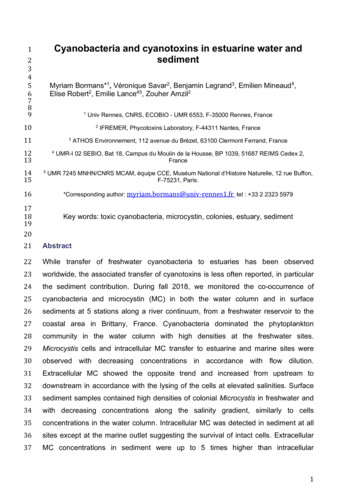
Transcription
Cyanobacteria and cyanotoxins in estuarine water andsediment123456789Myriam Bormans*1, Véronique Savar2, Benjamin Legrand3, Emilien Mineaud1,Elise Robert2, Emilie Lance45, Zouher Amzil21102113121314151617181920Univ Rennes, CNRS, ECOBIO - UMR 6553, F-35000 Rennes, France45IFREMER, Phycotoxins Laboratory, F-44311 Nantes, FranceATHOS Environnement, 112 avenue du Brézet, 63100 Clermont Ferrand, FranceUMR-I 02 SEBIO, Bat 18, Campus du Moulin de la Housse, BP 1039, 51687 REIMS Cedex 2,FranceUMR 7245 MNHN/CNRS MCAM, équipe CCE, Muséum National d’Histoire Naturelle, 12 rue Buffon,F-75231, Paris.*Corresponding author: myriam.bormans@univ-rennes1.fr tel : 33 2 2323 5979Key words: toxic cyanobacteria, microcystin, colonies, estuary, sediment21Abstract22While transfer of freshwater cyanobacteria to estuaries has been observed23worldwide, the associated transfer of cyanotoxins is less often reported, in particular24the sediment contribution. During fall 2018, we monitored the co-occurrence of25cyanobacteria and microcystin (MC) in both the water column and in surface26sediments at 5 stations along a river continuum, from a freshwater reservoir to the27coastal area in Brittany, France. Cyanobacteria dominated the phytoplankton28community in the water column with high densities at the freshwater sites.29Microcystis cells and intracellular MC transfer to estuarine and marine sites were30observed with decreasing concentrations in accordance with flow dilution.31Extracellular MC showed the opposite trend and increased from upstream to32downstream in accordance with the lysing of the cells at elevated salinities. Surface33sediment samples contained high densities of colonial Microcystis in freshwater and34with decreasing concentrations along the salinity gradient, similarly to cells35concentrations in the water column. Intracellular MC was detected in sediment at all36sites except at the marine outlet suggesting the survival of intact cells. Extracellular37MC concentrations in sediment were up to 5 times higher than intracellular1
38concentrations suggesting incomplete MC degradation. mcyB genes were present at39all sites while mcyA genes were absent at the marine outlet suggesting the presence40of toxic strains along the estuary. The high densities of intact colonies of potentially41toxic Microcystis in the estuarine sediment strongly suggest that sediments can act42as an inoculum of cyanobacteria and cyanotoxins in estuaries.43444546471. Introduction48proliferations have been increasing in recent years as a result of anthropogenic49activities including eutrophication and climate warming (O’Neil et al. 2012; Rigosi et50al. 2014; Paerl 2018). Freshwater cyanobacteria produce a large variety of toxins51(including hepatotoxins, neurotoxins, dermatotoxins) which have strong negative52impact on animal and human health (Lance et al. 2010; Metcalf and Codd 2012;53Wood 2016 for a review, Meriluoto et al. 2017). Among the diversity of cyanotoxins,54microcystin (MC) is largely recognized as the most common and widespread in55freshwater ecosystems (Harke et al. 2016). The general structure of those cyclic56heptapeptides includes a specific beta amino -4,6-decadienoic acid-Adda (Ortiz et al. 2017; Tillett et al. 2000)58as well as two amino acids that can vary leading to the identification of more than59250 MC variants (Puddick et al. 2014). The regulation and synthesis of MC, as well60as its ecological role, are complex and not yet fully understood (Omidi et al. 2017).Cyanobacterial blooms have been reported worldwide (Merel et al. 2013) and their6162The transfer of freshwater cyanobacteria to estuaries has been observed worldwide63(Preece et al. 2017 for a review), in Africa (Ndlela et al. 2016), USA (e.g. Lehman et64al. 2005; Peacock et al. 2018), South America (e.g. Dörr et al. 2010), Australia65(Robson and Hamilton 2003; Orr et al. 2004), Europe (e.g.Verspagen et al. 2006;66Tonk et al. 2007; Paldavičiene et al. 2009; Bormans et al. 2019), and Turkey (Taş et67al. 2006). The majority of these studies reported on the cyanobacterial transfer being68dominated by Microcystis aeruginosa demonstrating a certain salt tolerance of that69species. The associated transfer of intracellular or extracellular MC along the river70continuum was less often reported (Preece et al. 2017). In particular MC transfer to71the coastal environment resulting from freshwater discharge from an upstream2
72reservoir has only been reported in Italy (De Pace et al. 2014), Japan (Umehara et al.732012; 2015) and recently in France (Bormans et al. 2019).7475To our knowledge, MC occurrence in estuarine sediment has only been reported in76Isahaya Bay, Japan (Umehara et al. 2012, 2015), and in sub-estuaries of the Baltic77Sea (Paldaviciene et al. 2015) and Chesapeake Bay, USA (Bukaveckas et al. 2017)78while cyanobacterial (e.g. Microcystis) occurrence in estuarine sediment has never79been demonstrated. Hence, given the demonstrated contamination of estuarine and80marine benthic and pelagic organisms (Preece et al. 2015; Gibble et al. 2016;81Bukaveckas et al. 2017, 2018), as well as the high potential for tidal derived sediment82resuspension in estuaries (Labry et al. 2016) we wanted to investigate the sediment’s83contribution of a French estuary as a potential source/sink of both cyanobacteria and84MC.8586Here we report on the co-occurrence of both cyanobacteria and microcystin in the87water column and in surface sediment along a river continuum from a freshwater88reservoir discharge to the marine environment during fall 2018. This study is part of a89larger project aiming at the evaluation of the potential risk of contamination of aquatic90organisms (i.e. bivalves) by cyanotoxins during transfer from a freshwater reservoir to91an92phytoplankton/cyanobacterial species composition, and concentrations of different93variants of MC both in intracellular and extracellular forms. The quantification of94those two forms of toxins are necessary as we anticipate gradual cells lysing along95the salinity gradient. We also report on the presence of microcystin producing genes96mcyA and mcyB together with the anaC gene in surface sediment to assess the97potential toxicity of estuarine ,France.Wepresentresultson2. Materials and methods2.1. Study site and sampling protocolsWe chose to investigate a site in Brittany where most of the French agricultural lands105are located and where reports of toxic blooms have been numerous in freshwater106lakes and reservoirs (Vezie et al. 1998; Brient et al. 2009; Pitois et al. 2018).107Moreover, in Brittany, most rivers have short residence times (Fraisse et al, 2013)3
108and as a result reservoirs are generally close to marine outlets. The study site is109located in the Morbihan (Brittany, France) along a continuum of moderate length ( 10110km), from the Pen Mur freshwater reservoir upstream through the Saint Eloi River,111the Pen Lann estuary and the marine outlet (Fig. 1). Pen Mur reservoir is used for112drinking water and it is monitored by the Regional Health Agency (ARS). The113reservoir experiences recurrent intense cyanobacterial blooms dominated by the114genus Microcystis (Bormans et al. 2019). Freshwater discharge from the reservoir to115the estuary is frequently observed but not monitored and therefore not quantified.116117During fall 2018, we sampled on October 10, at 5 stations along a freshwater-marine118gradient, where F1 in the Pen Mur reservoir and F2 in the river downstream of the119reservoir are both in the freshwater section, E1 and E2 are located in the estuarine120section, and the site M is located at the entrance of the marine section (Fig. 1). In121particular, we sampled the 3 downstream stations within 1 hour of low tide to122maximize the freshwater discharge and minimize the tidal contribution.123124125Fig. 1: Map of the study site and sampling stations: F1 and F2 are located in the126freshwater section, E1 and E2 in the estuarine section and M at the marine outlet.4
127128At each station, subsurface grab water sampling was carried out in the water column129to: i) determine physico-chemical parameters (temperature, conductivity, dissolved130oxygen, Phosphorus and Nitrogen) using a YSI 6920 multi-parameter probe (YSI131Environmental, Anhydre) and physico-chemical analyses, ii) describe phytoplankton132and cyanobacterial species (identification and enumeration), and (iii) quantify133microcystins in the phytoplanktonic biomass and in the filtered water. At each station,134surface sediment sampling (top 1 to 2 cm) was carried out to (i) determine sediment135characteristics including percentage of organic matter (OM) and major elements, ii)136identify and count phytoplankton species including cyanobacteria, (iii) quantify137cyanotoxins and (iv) determine the presence of MC and anatoxin production genes. It138is important to note that for the sampling of surface sediment, the site F1 was chosen139in the river directly downstream of the reservoir, as no sediment was found in the140reservoir itself at the site where the water column sampling was performed, the141bottom there being dominated by larger rocks.1421431441451461471482.2. Samples Analyses2.2.1. Water analysesWater column samples were transported in dark and cold conditions and filtered149upon arrival at the laboratory within few hours of sampling. Dissolved inorganic150nutrient concentrations were measured from filtered (GF/F 0.7 µm) water using151common colorimetric methods with a Bran and Luebbe Autoanalyser 3 (Axflow,152Norderstedt, Germany). Nitrate was measured after reduction to nitrite on a153cadmium-copper column (Henriksen and Selmer-Olsen 1970). Phosphate was154measured following the method of Murphy and Riley (1962). Filtration was also done155to determine total suspended solids (TSS). Whatman glass fiber filters (GF/F 0.7 µm)156were dried at 105 C and weighed. Ashing to 550 C was performed to determine the157organic contribution. Phytoplankton and cyanobacteria identification and counts were158conducted on both fresh and lugolised samples under an optical microscope (100x159magnification) using a Nageotte chamber within 48 hours of sampling as reported in160Lance et al. (2010) and Pannard et al. (2018). This was preferred over a161haemocytometer chamber for the larger volume sampled to limit counting errors as162described in Brient et al. (2008).5
1631642.2.1.1. Microcystin extraction165Water samples containing cyanobacteria were filtered upon arrival at the laboratory166through a 0.1 µm GF filter to separate the cell pellet for the intracellular cyanotoxin167analysis and the filtrate which may contain dissolved extracellular toxins. Both filters168and filtrates were frozen at -20 C until chemical analysis. The filtrate was purified on169a C18 SPE cartridge (Solid Phase Extraction) according to the ISO 20179 standard170method (Anon, 2005). The fraction containing the toxins was frozen until LC-MS/MS171analysis. The GF filter was sonicated with 10 mL of MeOH for 15 minutes. The172MeOH extract was evaporated under nitrogen and then the residue was diluted in 1.5173mL of methanol.1741751761771782.2.2. Sediment samplesFresh surface sediment was kept in the dark and at 4 C until analyses. Sediment179characteristics including major elements and % organic matter (OM) were analysed180by the SARM (Service d’Analyse des Roches et des Minéraux) laboratory (Nancy,181France) using an ICP-MS iCapQ instrument.1821832.2.2.1. Extraction of cyanobacteria184Cyanobacteria were extracted from sediment using a density gradient with Ludox185TM-50 (Sigma-Aldrich, Saint Louis, USA), as described in Legrand et al. (2016). 0.5g186of fresh sediment was diluted with 9.5 ml of distilled water and 4 ml of Ludox. These187solutions were sonicated for 30 seconds with a frequency of 50% and a power of 80188W (Sonoplus, Bandelin, Berlin, Germany). Finally, solutions were centrifuged at18910,000 x g for 30 minutes and after the first 6 ml was pipetted and kept in the dark at1904 C for further analysis.1911922.2.2.2. Estimation of cyanobacterial abundance193Genus determination for vegetative cells and akinetes (Nostocale resting stage cells)194was based on morphological criteria using reference books (Bourelly 1985; Komàrek195and Anagnostidis 2005, 2013). 2 ml of Ludox solution was filtered through an 8-µm196mesh (TETP filter; Merck Millipore, Tullagreen, Ireland). Counts were performed in197triplicate for each sample in this study. Cyanobacteria were enumerated at a6
198magnification of x200 with an epifluorescence microscope (Axiovert 200 M; Zeiss,199Oberkochen, Germany) and a minimum of 40 fields was counted for each filter. One200sample (F2) was tested for cell viability with SYTOX green following Legrand et al.201(2016). Briefly, 1µL of SYTOX green (50 mM) was added for 1 mL of isolated202cyanobacterial solution. Resulting solution was incubated in the dark at least for 30203min. 1 mL of this solution was filtered using an 8 µm filter (TETP, Merck Millipore,204Tullagreen, Ireland). The sample was enumerated with the same epifluorescence205microscope than previously. Two separate counts were performed: the first at 546206nm to determine intact cells sill containing chlorophyll pigment; and the second at207448 nm to discriminate damaged cells with SYTOX green staining.2082092.2.2.3. DNA extraction and target genes amplification210Genomic DNA from sediment samples was extracted with the FastDNA Spin kit for211soil (MP biomedicals, Santa Ana, USA) following the manufacturer’s instructions. The212DNA concentration in each sample was estimated using a UV spectrophotometer213(Nanodrop ND 2000). The cyanobacterial 16S rRNA gene was amplified in214sediment samples using the cya359F and cya781R set of primers from Nubel et al.215(1997). Then, two genes involved in the biosynthesis of microcystin, mcyA and mcyB216genes and one gene involved in the biosynthesis of anatoxin-a, anaC, were also217investigated in this study, given the cyanobacterial species found in sediment. anaC218and mcyB were amplified with nested PCRs whereas classic PCR was used to detect219mcyA. For mcyB nested PCR, MCY F1/R1 then MCY F1/R2 were used and220mcyA Cd1F and mcyA-Cd1R for mcyA. anaC was detected with the sets of primers221anxgen-F2/R and anaC 80F/706R for nested 1 and 2 PCR respectively. All PCR222mixtures and PCR programs were the same as described in Legrand et al. (2017). All223PCR products were revealed with 0.5% agarose gel with 0.3 mg L-1 ethidium bromide224and migrated in a TAE buffer 0.5X at 100V for 30 minutes.2252262.2.2.4. Microcystin extraction227To analyse total MC (intracellular plus extracellular), the crude sediment228(approximately 2 g) were extracted, according to the method of Umehara et al229(2012), 4 times with 4 ml of MeOH/H2O (30%/70%), each time using sonication for 45230min and then centrifugation at 3500 g at 4 C for 10 min. To analyse intracellular7
231MC, the ludox supernatant containing cyanobacteria was filtered under pressure232(around 53kPA) using 25 µm nylon filtration tissues in order to eliminate akinetes and233extracellular MC. These tissues were cleaned with distilled water under pressure 3234times. Then, tissues containing Microcystis were cleaned with methanol 100%.235These solutions were kept in dark conditions at 4 C until further analysis.2362372382392.2.3 Chemical analysis of microcystins by LC-MS / MS240All extracts obtained from the water column and surface sediment were filtered241through a 0.2 µm filter and analyzed by Ultra Fast Liquid Chromatography242(Shimadzu, Marne la Vallée, France) coupled to API-5500 QTrap tandem mass243spectrometry (ABSciex, Villebon sur Yvette, France). Toxins were separated on a244Kinetex XB C18 column (100 x 2.1 mm, 2.6 µm, Phenomenex) at 25 C, with water245(A) and acetonitrile (B), both containing 0.1% formic acid at 0.3 mL min-1 flow rate.246The gradient was raised from 30 to 80% B in 5 min and was held during 1 min before247dropping down during 0.5 min to the initial conditions.248249Mass spectrometry detection was carried out in multiple reactions monitoring (MRM)250mode. The electrospray ionization interface (ESI) was operated in positive mode251using source setting: curtain gas set at 30 psi, ion spray at 5000 V, a turbogas252temperature of 300 C, gas 1 and 2 set at 30 and 40 psi respectively and an entrance253potential of 10 V. Each toxin was identified and quantified with two transitions as254follow (Table S1): The toxin concentrations were determined using certified255standards provided by CNRC (Halifax, NS, Canada). The method was developed256and validated internally in the IFREMER Phycotoxins laboratory.2572582592602612622632648
265266267268269270271272273274275Table S1: LC-MS/MS transitions for the 9 MC variants tested with standardsToxinPrecursor ion (m/z)995.6Transition (m/z) Quantification213.2Transition (m/z) MC-LA910.7375.2135.2MC-YR1045.6213.2375.23. Results3.1. In the water column3.1.1. Physico-chemical parametersThe physico-chemical characteristics of the water sampled at each site along the276continuum are presented in Table 1. While temperature was constant along the277continuum, conductivity (as a proxy of salinity) increased from upstream to278downstream. Dissolved oxygen exhibited a decreasing concentration associated with279a simultaneous decrease in Chl a concentration. Nitrate presented an upstream to280downstream decrease while phosphate values showed the opposing trend with281higher values downstream. The total suspended solids in the water column exhibited282higher concentrations downstream in the estuary and revealed a decreasing gradient283in percentage of organic matter (OM) varying from 100% in freshwater to 24% at the284marine site.2852862872882892902919
292293Table 1 : Physico-chemical parameters measured in the water at the 5 samplingstationsSitesF1F2E1E2MTemp( 045.3540.21O2(mg/L)13.6710.919.618.637.84Chl 085.335.930.524.72942952963.1.2. Phytoplankton/Cyanobacteria community297In the water column, the phytoplankton community was largely dominated by298cyanobacteria in cells density (Fig. 2). In particular several species of the Microcystis299genus (M. aeruginosa, M. botrys, M. viridis and M. flos-aquae) accounted for most of300the cells density at the freshwater sites. M. aeruginosa was the only cyanobacterial301species observed in the estuary with a concentration of 3.7x104 cells mL-1 at E1.302Several Chlorophyceae and pennate diatoms were also recorded in the estuary in303low numbers ( 103 cells mL-1).F1100 000F2Phytoplanktondensity (cells mL-1)1 000 00010 0001 iPeanntomatsediatomEusglenasp.1304305306307308Fig 2: Species composition and phytoplankton density in the water column at the 5stations along the freshwater-marine continuum on October 10, 201810
309The biovolumes of the phytoplankton groups present together with the percentage of310cyanobacteria in the total biovolume of phytoplankton at each site are presented in311Table 2, demonstrating the strong dominance of cyanobacteria at the three most312upstream sites.313314315Table 2 : Biovolume of phytoplankton groups at each sampling siteBiovolume (mm3 000.0000.0000.0080.000
11 3 ATHOS Environnement, 112 avenue du Brézet, 63100 Clermont Ferrand, France 12 4 UMR-I 02 SEBIO, Bat 18, Campus du Mou











